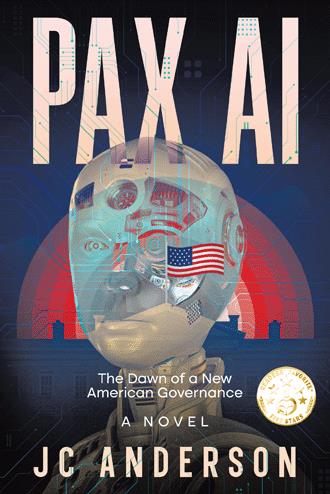The unimaginable seemed natural to everyone when the “system” finally failed and the U.S. Constitution no longer commanded the credibility needed for governance. In the end, the Constitution had come to be viewed as an archaic document so lacking in precision that the people who ran the government were no longer capable of acting in accordance with its principles. And once the Constitution could no longer serve its intended purpose, the last remaining barrier between chaos and the semblance of order was breached. George Washington’s fears of a government corrupted by political parties had after 253 years become a reality. Party politicians walked out of congressional sessions in unison whenever a vote was being taken on an issue that the opposite party with majority power wanted to pass, just to break quorum. In one state, it got so bad that party politicians were taking refuge on Native American reservations just to avoid arrest by the governor. What was needed when the politicians failed the people was an impartial, nonpartisan, and above all, highly capable system based on artificial intelligence—as opposed to human intelligence, which was distorted by greed, corruption, and incompetence. And everybody knew it.
In the modern age of high technology competence and capability, humans were failing on all fronts; they were growing lazy. The default mantra was “Let the computer do it!” In short, they could not effectively keep up with the vast spectrum of problems that were growing with logarithmic complexity. The computer was becoming smarter than the people because it was actually doing the work. The computer easily replicated—and improved upon—the logical thought processes of the human brain with the blessing and aid of the people. And while the implications of turning the government over to an AI system were not totally understood, it was clear that the complexity of the decades-old mess created by politicians was so great it could no longer be untangled by humans. The American public had been apathetically living in what the press termed WHOGAS (Who Gives a S***) Mode. WHOGAS Mode gave way to what Wall Street called TINA, for financial situations where “There Is No Alternative.” It seemed clear to the majority of Americans that this was a TINA moment.
The U.S. Constitution not only failed, but was deemed responsible for the failure, because its vagueness and brilliant ambiguity of language led to constant, growing angst and political turmoil. The philosophical eloquence of eighteenth-century political writing was imbued with subjective words and phrases that quite simply did not age well in an unenlightened and poorly educated citizenry. So-called “sacred phrases” such as “freedom of speech” and “the right to bear arms” became highly toxic over time; by 2044, they had degenerated into open sieves for worthless and debilitating legal and political wrangling, giving detrimental advantage to ne’er-do-well lawyers, political hacks, and unsavory businesspeople seeking to prosper by gaming the system.
This political frustration had been steadily building for the last several decades, like ever-growing silent fumes from a pile of garage rags getting ready to ignite through spontaneous combustion, in the form of administrative thrashing on the four-year electoral cycle. Elected presidents (in recent times thrown out after one term) and their partisans would undo the previous president’s actions and agendas via essentially unauthorized executive orders. One step forward, one step back, one step forward, and so on to the point where objectivity and any semblance of factual analysis had long since disappeared. This thrashing also eroded America’s credibility as a reliable leader on the world stage. Meanwhile as the twenty-first century proceeded, success was being achieved by “command and control” driven governments such as exhibited by the leading Chinese model (as corrupt and dictatorial as it was). The Chinese, for example, had long discarded the Confucian call for endless study and debate that held societal progress back for hundreds of years.
When the acknowledged crash finally came—due in part to the thrashing and petty partisan wrangling that had metastasized throughout the body politic—enough mercifully became enough in an age of “exquisite computing,” and the endless, worthless debating over the furtive and flowery phrases inherited from the Founders via the Constitution came to a screeching halt.
Government, corporate, cultural, and religious organizations were increasingly turning to artificial intelligence and ultra-fast computer system technology to address problems, analyze information, predict outcomes, and efficiently produce goods and services. The turning point for this confidence was the driverless automobile. Once people grew confident in taking their hands off the steering wheel and foot brake, their mindset changed. This AI stuff was working! Day-to-day life had in fact been massively transformed for the better, encouraging both a new dependence on and respect for the power of technology.
Amazingly enough, when people gave up control to an intelligent system, an air of excitement began building in America for the “peace” that would come with a new age of AI-controlled government—one that was indisputably fair, objective, and above all, competent. A government no longer run by a small cadre of overly-influential individuals. People genuinely came to realize that partisan bickering was holding the nation back from solving chronic problems like racial reform, social injustice, fraud and abuse, endless litigation, poor education, destructive periods of economic boom and bust, and power plays between states and the federal government. Getting the politicians OUT was universally hailed as the right next step to take. The thinking was that when the politicians were out of commission, so, too, would be the special interest groups and lobbyists, and the petty, debilitating partisan squabbling that held society back from reaching its true potential would finally cease.
The mounting decades of societal frustration reached a breaking point (akin to the onset of a nervous breakdown) after the Crash of 2030. Rarely before in American history had the people been so united in their belief that the end truly had come for tired concepts handed down by the “framers.”


